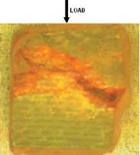The first observation that one can make, for out-of-plane tests, is that material shows a greater strength. The damage appears only for the great impact pressures: 0.8bar for [0°]40, 1.4 -1.6bar for ([20°]20 and [30°]20) and 1.4bar for [45°]20. For this lower range of impact pressure there were only residual "plastic" deformations due to matrix cracks. One can also notice that the nature of the damage is strongly affected by the laminates orientation, which stills a parameter in improving also out of plane dynamic compressive strength. The multiplication of the microscopic cracks involves the catastrophic failure. The high strength recorded for 20° and 30° can be correlated with damaging modes observed and reported in figure 22. In fact for these specimens multiple mode fracture is depicted. As the strain rate increase more damage mechanism is involved; from matrix cracking to delamination with multiple paths to final fracture. For 0° and 45° specimens a dominant path is observed along the weakest link, respectively across weft yarns and plies interfaces, which may explain the lower strength. The kinetics of damage for this direction of loading is strongly conditioned by the specimen’s fibre orientations. Figures 23 and 24 summarize the history of damaging modes for the various laminates.
|
|
|
|
|
|
|
|
|
|
|
|
|
|
|
|
|
|
|
|
|
|
|
|




6. Conclusions
In this work, the high strain rate material response of [0]4o, [+20]20, [+30]20, [+45]20, [+60]20, [+70]20 and [90]40 E-glass/epoxy composite material systems was investigated. A Split Hopkinson pressure bar was used to conduct high strain rate experiments. Maximum strain rates around 2000s-1 were achieved. Samples were subjected to IP and OP tests. The first observation can be made, for in-plane tests, is that materials show a strength dependency on fibre orientation and impact pressure. Damage appears only for specific impact pressures: 1.2bar for [0]4fl, 0.9-1bar for ([+20]20 – [+30]20), 0.9bar for [+45]20, 0.7-0.8bar for ([+60]20 – [+70]20) and 0.6bar for [90]40. For this lower range of impact pressure there was no macroscopic damage but the existence of microscopic damage remains a possibility. It can also be noticed that the nature of the damage is strongly affected by the orientation of the laminates, a major parameter in improving dynamic compressive strength. The multiplication of the microscopic and macroscopic damage involves catastrophic failure. For these specimens a multiple fracture mode is determined and described. As the strain rate increases more damage mechanisms are involved; from matrix cracks to delamination with multiple paths to final fracture. The damage kinetics for in-plane loading is strongly conditioned by the specimen’s fibre orientations. The initiation and propagation of failure mechanisms at different strain rates have been examined. Specimens fail due to fibre kinking at low strain rates, with delamination and interfacial separation dominating the high strain rate failure regime.
For OP tests, the stress-strain curves of the composite materials show that the material is strongly sensitive to fibre orientation at the same impact pressure: the initial modulus of elasticity and maximum failure stress, strain at maximum stress and the maximum strain are all dependent on fibre orientation and strain rates. The initiation and propagation of failure mechanisms at different strain rates have been examined. The most pronounced effect of increasing the strain rate results in changes in the failure modes. Off-axis composites and angle ply laminates exhibited significant nonlinear and strain dependent behaviour. The glass/epoxy composite material is more resistant for OP loading. Indeed, the damage appears for high pressure.






